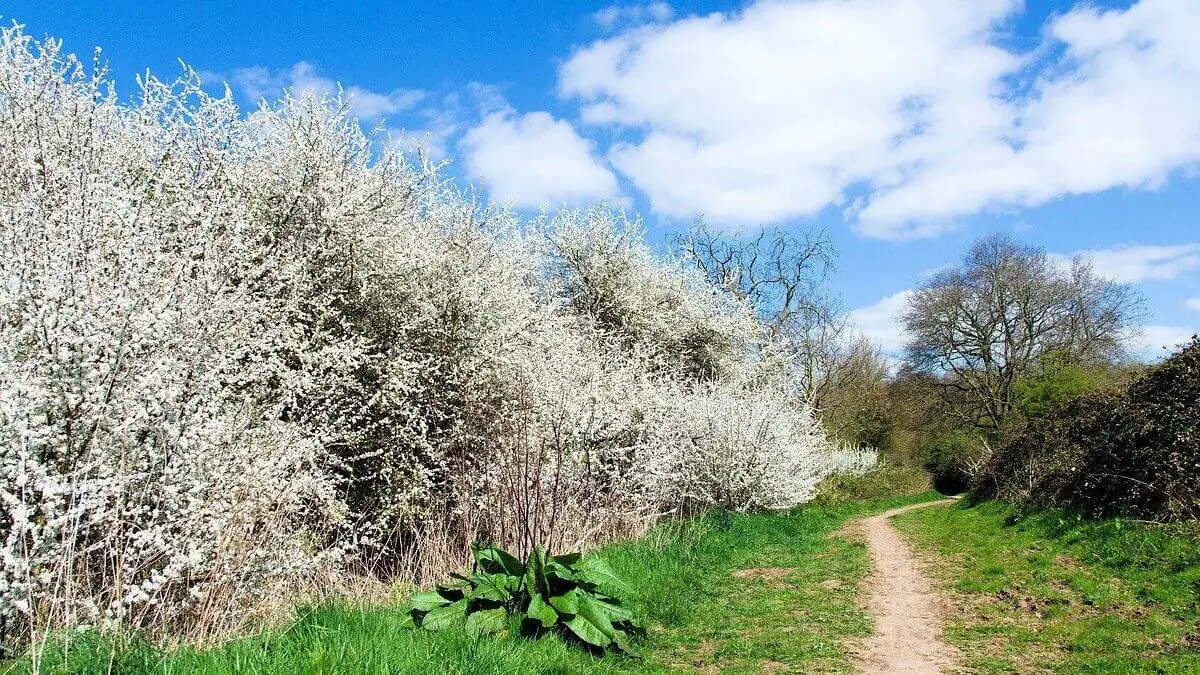How to Grow Spirea Bushes
Spirea bushes belong to the Rosaceae family. Sometimes, they are also spelled as Spiraea. Their other common names include steeplebushes and meadowsweets. The genus of spirea bushes has about 100 species of shrubs.
These bushes are mostly indigenous to temperate regions in the northern hemisphere. Their greatest diversity is commonly found in eastern Asia, particularly eastern China.
This article primarily focuses on spirea bushes, their propagation, caring, varieties, and uses.
Generally, these multi-season beauties grow quicker and are easy to care for. Due to these versatile characteristics, they are one of the most popular bushes in the floral market.
With fine-textured foliage and long-lasting blooming periods, these shrubs fit almost any landscape. You can use them for mass plantings, hedging, ground cover, and also in perennial beds.
In addition, modern cultivates exhibit more versatile characteristics with multi-season colors and tidier growth. In most cases, these bushes are deer resistant and attract pollinators.
Table of Contents
Description of Spirea Bushes
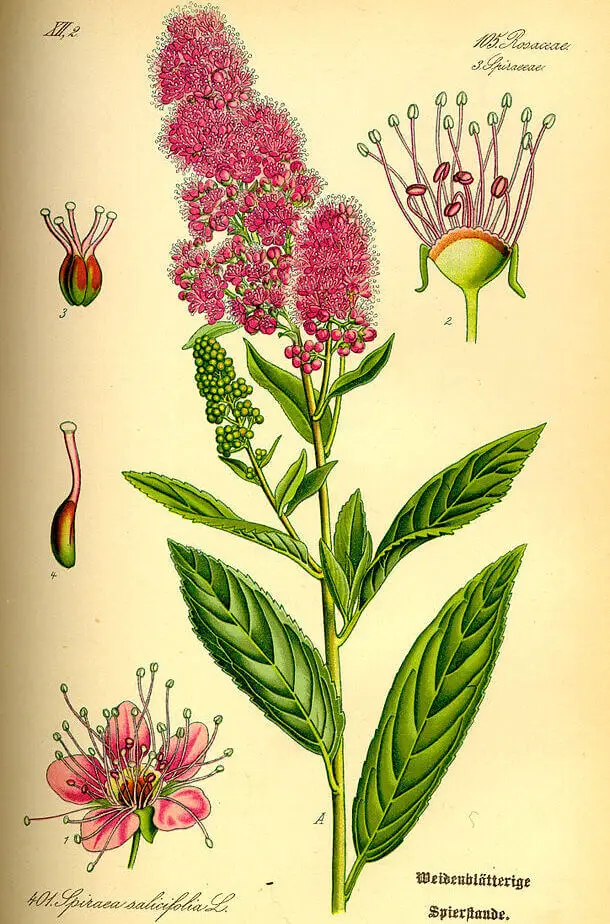
Generally, spirea bushes are hardy in USDA zones 4 – 8. However, some varieties can tolerate even more cold and hot weather. They can grow 1-8 feet tall and spread about 6 feet wide.
These bushes have lanceolate, deciduous leaves. Arranged in an alternative, spiraling fashion, the simple leaves are usually short-stalked. They measure about 0.98 – 3.94 inches (2.5 – 10 cm) long.
Usually, the leaves have toothed margins. Depending on the cultivar type, sometimes they may have lobed or even smooth margins. In most cases, the Stipules are not available.
The flowers are usually red, pink, or white in color. Mostly, they are bisexual. But in rare cases, they can be unisexual too.
The flowers have five sepals and five petals. Usually, the petals are longer than the sepals. Each flower has about 15 – 60 stamens. Normally, the flowers of these shrubs develop in clusters and have fivefold radial symmetries.
Classification
Classified as spring flowering plants and summer flowering plants, spirea bushes develop abundant flowers in clusters.
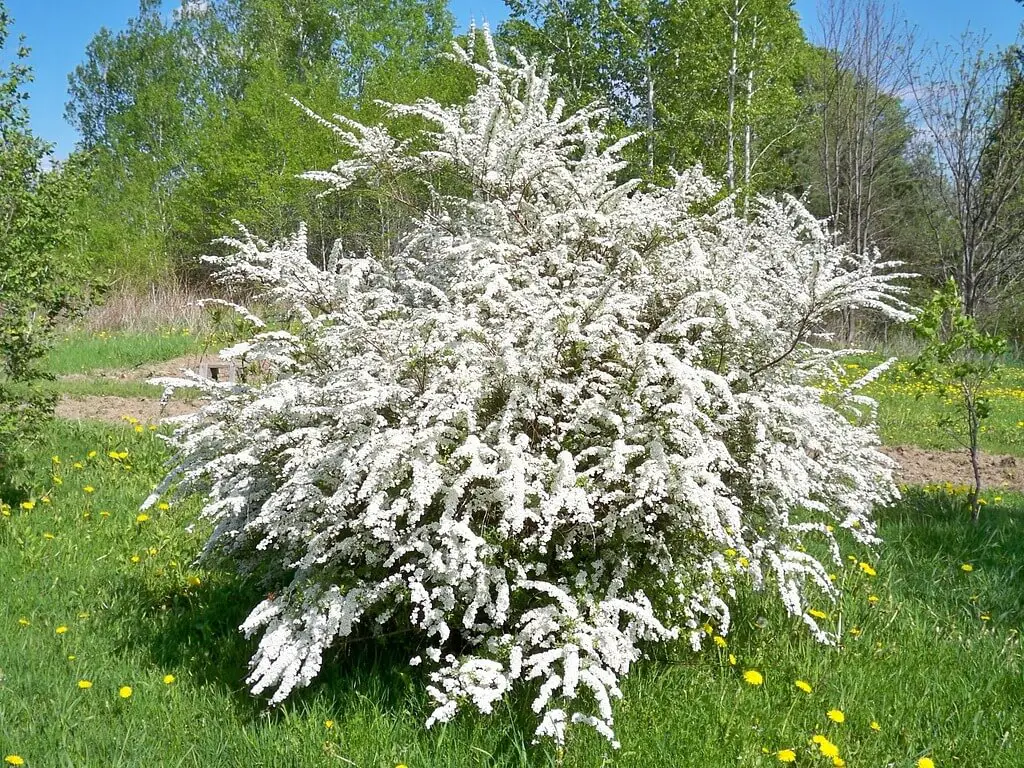
Normally, most spring flowering plants have cascading habits. The Bridal wreath spirea plant is a good example. They bloom an abundance of flowers during April, May months along their beautiful bowing branches. In most cases, the flowers are white.
The summer flowering plants bloom white, pink, or red flowers on top of the upright stems. They usually bloom between June – August depending on the cultivar. The colorful appearance continues in fall too with beautiful red foliage.
Propagation of Spirea Bushes
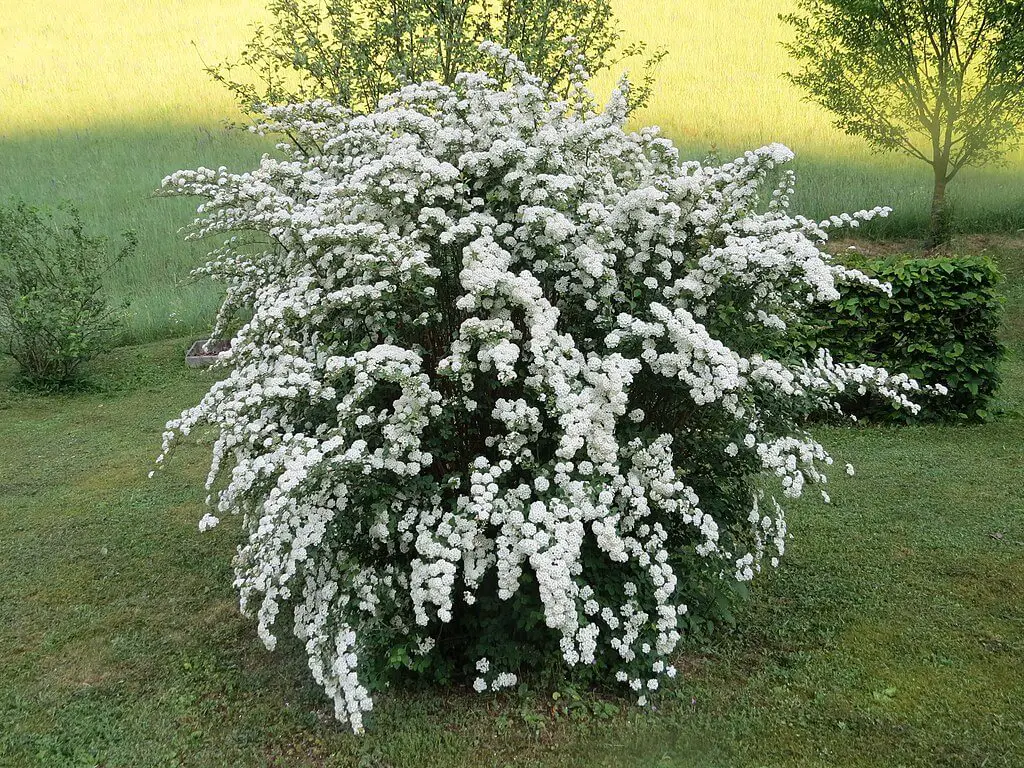
Photo by GT1976 (Wikimedia Commons) (CC BY-SA 4.0)
Generally, spirea bushes are easy to propagate and care for. They are one of the fast-growing plants available in the market. Select a spot that receives at least 6 hours of direct sunlight every day. These plants prefer to grow in well-draining, slightly acidic soil with a pH value between 6 – 7.
Softwood Cutting
Start softwood cutting propagation process in summer.
1.) Select flexible stems. Using garden shears, cut them about 10 – 12 inches from the top.
2.) Trim the top half portion of the stem. Then, remove the leaves and other debris from the bottom half portion of the stems.
3.) Dip the bottom end in a good quality powdered rooting hormone. After that, take the stem out and shake off the excess hormone powder.
4.) Select a mid-sized pot that has good drainage facilities. Fill it with a potting mixture and water it well.
5.) Plant about 3 – 4 stems in the pot. To retain the moisture, cover the arrangement in a plastic bag and seal it.
6.) Place the pot in a dappled shade location. To maintain the soil moisture, check and water at least once a week
In about a month’s time, you can expect rooting of the stems. After rooting, you can repot them in individual planting containers. During winters, tuck the containers indoors. Then, you can grow them outdoors in spring.
Hardwood Cutting
During winters, the plants go dormant. This is the perfect time to cut the hardwoods from mature stems. The ideal time for cutting hardwood is just after the autumn’s leaf drop season or just before the winter’s bud burst season, avoiding severe frosts.
1.) Using garden shears, cut mature stems about 10 – 12 inches from the top.
2.) Trim the top portion of the stem. Then, remove the foliage from the bottom half of the stem (preferably below the leaf node, if available)
3.) Dig holes for cuttings about 6 inches deep.
4.) Placing the cuttings in an upright position, backfill the soil, and close the hole firmly.
5.) Water the cuttings well initially
6.) By watering regularly, maintain the soil moisture.
In about a month’s time, you can expect the rooting of the cuttings. During the spring, you can transplant them in pots or continue to grow them in gardens.
Ground Layering
Ground Layering is a simple, effective method of propagation. In this method, the stems remain attached to the host plant and root from the portion pinned to the ground.
During spring, the plants would be bustling with energy for developing new growth. This is the perfect time to start the layering process.
1.) Select a long, flexible shoot from the outside edge of the spirea bushes.
2.) From the portion that is easy to be pinned underground, gently remove the barks for about 3 – 4 inches.
3.) Remove the leaves and other matter on either side of the scraped portion of the stem.
4.) Did a trench about 3 inches long and at least 1 inch deep.
5.) Now bury the scraped section portion of the shoot in the trench and pin it with landscape or tent pins.
6.) Backfill the dug-out soil in the trench and water it well.
7.) By monitoring and watering periodically, maintain the soil moist but not allow it to be soggy.
You can expect new roots in about a couple of months. After that, sever the stem from the host plant and transplant it in pots or permanent locations.
Caring Spirea Bushes
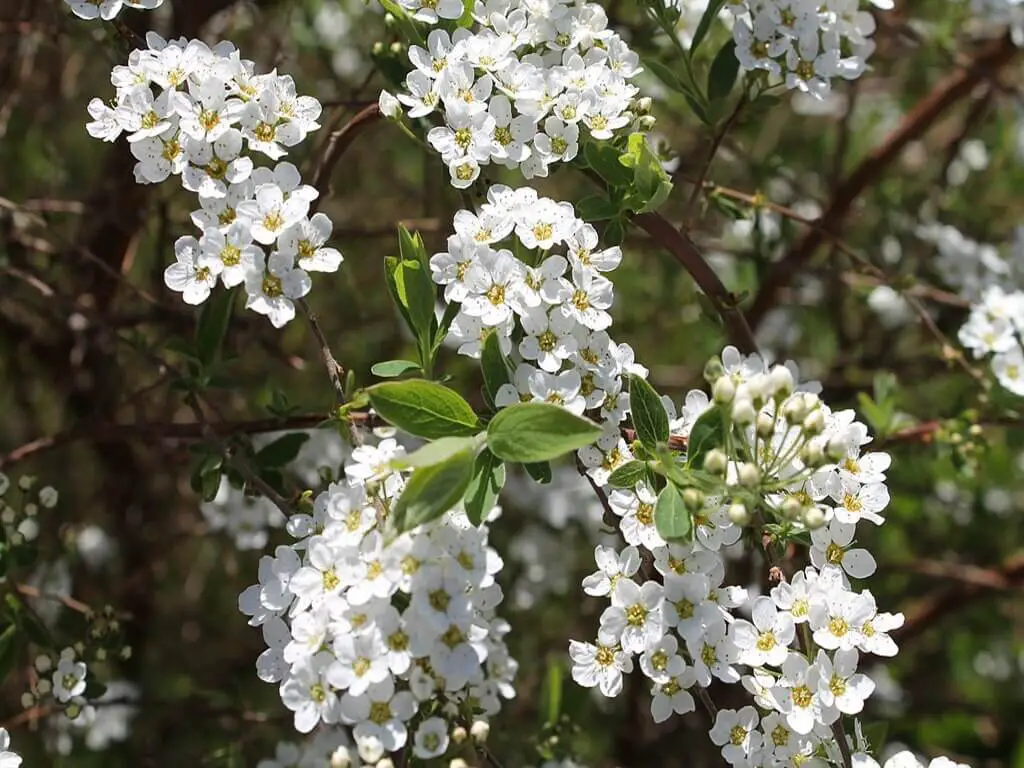
Photo by Bernt Fransson (Wikimedia Commons) (CC BY-SA 4.0)
Fertilizer
Spirea bushes in general, are not heavy feeders. Hence, avoid overfertilizing to prevent sprawling of the foliage. During spring, slightly apply a balanced (controlled) time-release fertilizer like NPK 10-10-10. This will provide enough nutrition to the plants for the entire year.
Watering
Until the young plants mature, water them well. After that, the established plants begin to exhibit drought-tolerant characteristics. So, water the spireas only when the soil dries. To prevent water-related diseases and pests, avoid oversaturating the soil.
Pruning
You can prune these plants both annually and occasionally. As these plants are fast growers, liberal pruning often has a negligible impact on the development of flowers.
Prune the spring flowering varieties right after flowering. This is because they bloom on the previous year’s old growth. You can prune them right to the surface of the ground. For compact growth, you can also trim them to any length.
Prune the summer flowering varieties in the winter after flowering. This is because they mostly bloom on fresh growth. In case of vigorous spreading, you can prune them about two thirds. You can also shape them by trimming them lightly.
However, it is advisable to shear both varieties lightly after flowering. Remove faded blooms, dead woods Etc., to invigorate fresh growth.
Mulching
Generally, the established spirea bushes are frost resistant. They do not require extensive winter care. However, the new bushes planted in the fall require mulching to protect the rooting systems from freezing colds.
In the case of container-grown plants, you can simply move them indoors or insulate them for cold protection.
Pests and Diseases
Mostly, spirea bushes do not suffer from serious pests or diseases. However, being a member of the Rosaceae (rose) family, they are rarely susceptible to pests and diseases that commonly affect this family.
Pests
Aphids and spider mites may occasionally bother these plants. Just by spraying a strong blaze of hose water, you can get rid of them. If the infection still persists, you can treat them with insecticidal soap or neem oil sprays.
By growing plants that attract beneficial insects nearby, you can naturally control these types of pesky insects.
Diseases
Powdery mildew is a common disease among most plants. It thrives in a cool, damp, and crowded environment. The infected foliage has a whiteish cream-colored powdered coating on its surface. This disease causes decolorization, stunted growth, leaf drop Etc.
The lightweight spores of this disease spread through wind, contaminated garden tools Etc., very easily.
To prevent these types of diseases, prune the plants occasionally and dispose of the dead woods, spent blooms, etc. This facilitates free air circulation around the foliage.
Treat the infected foliage with fungicides. If the problem still persists, remove the infected parts from the plant and dispose of them immediately. This action prevents the disease from spreading further.
Varieties of Spirea Bushes
In floral markets, you can find numerous spirea cultivars. We have listed a few popular spirea varieties below
Spiraea Japonica (Japanese Spirea)

Japanese spirea is one of the most popular varieties. It also has many cultivar types that offer different flower colors and foliage sizes. During summer, they develop clusters of flowers mostly in white, pink, red, and purple colors. Their textured foliage itself offers attractive looks, particularly in fall.
Different cultivars grow in different sizes such as dwarf types (under 3 feet), small growers (3 – 5 feet), and medium specimens (5 – 8 feet). Most of these types grow rounded and dense. The flowers usually develop on fresh growth. So, they require pruning after the following winter.
Japanese spirea bushes are hardy in USDA zones 3 – 8. They also exhibit similar characteristics to other varieties in resisting deer and attracting butterflies.
Spiraea Betulifolia (Birchleaf Spirea)
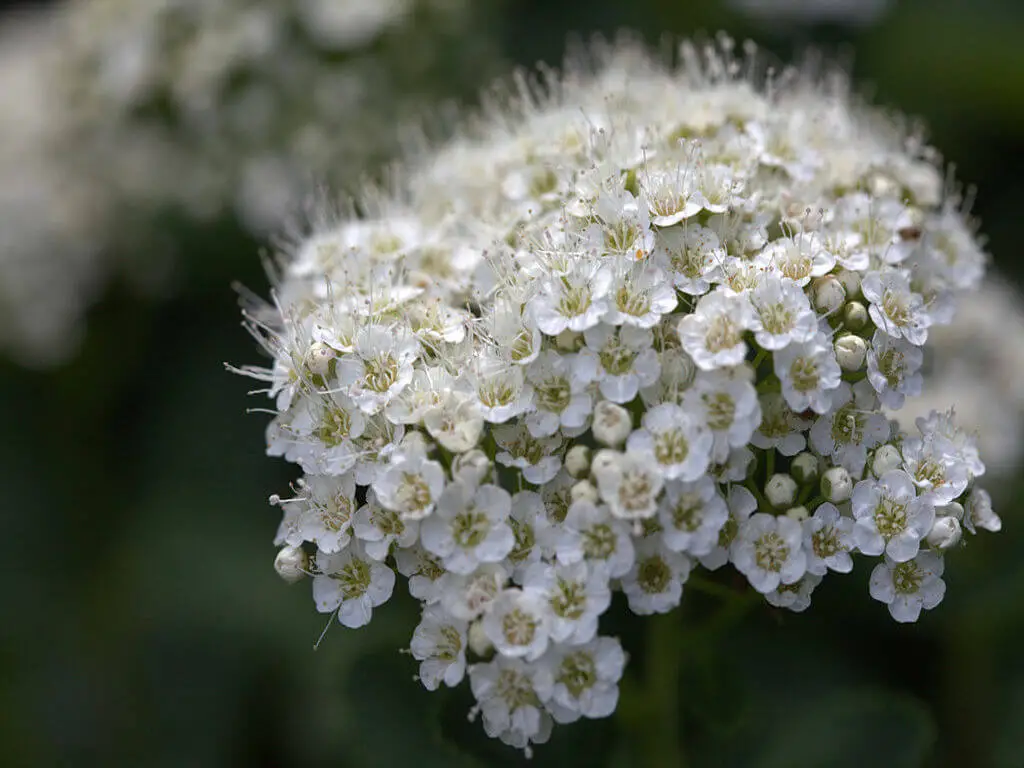
Photo by Averater (Wikimedia Commons) (CC BY-SA 3.0)
During the spring season, Birchleaf spirea develops small white flowers in clusters. This compact and rounded shrub grows about 3 – 4 feet tall and the same as wide. In autumn, the rounded dark green leaves turn vibrant red, purple, and orange.
Hardy to USDA zones 4 – 8, these showy bushes bloom in summer. You can encourage fresh growth by removing spent blooms in summer and pruning during the following winter.
Like other varieties, Birchleaf spirea also is deer resistant and attracts butterflies.
Spiraea Prunifolia (Bridalwreath Spirea)

Photo by Rronenow (Wikimedia Commons) (CC BY-SA 3.0)
An old-fashioned classic, Bridalwreath spirea sprouts cascades of double-petaled, tiny white flowers on arching branches. Usually, the flower clusters appear before the foliage in spring.
Bridalwreath spirea is one of the tall varieties that grow about 4- 8 feet in height and spreads about 6 – 8 feet wide. This variety usually grows loose in a fountain-like appearance.
As a spring-flowering variety, it requires pruning right after flowering. This variety is hardy in USDA zones 3 – 8. During Autumn, its fine serrated foliage turns shades of yellow, orange, red, etc., and provides beautiful looks.
Like most of the spirea varieties, Bridalwreath spirea is resistant to deer and attracts butterflies.
Uses of Spirea Bushes
Spirea bushes make an excellent specimen or foundation plant in mixed perennial beds, in landscapes, as hedging or edging plants, and also in en masse plantings as screens.
The dwarf or low growing varieties fit perfectly for small gardens. They also suite well as groundcovers, container plants, border plants, in low hedges along sidewalks, pathways, rockeries Etc.,
With their long-lasting characteristics, spirea flowers can beautify almost any floral arrangements like cut flower boutiques.
With enough sunlight, room to grow, and good drainage, spirea bushes can beautify your gardens with an abundance of beautiful flowers and fine-textured foliage.
Similar Plants
How to Grow Red Salvia (Scarlet Sage) Plants
How to Grow a Poinsettia Tree

